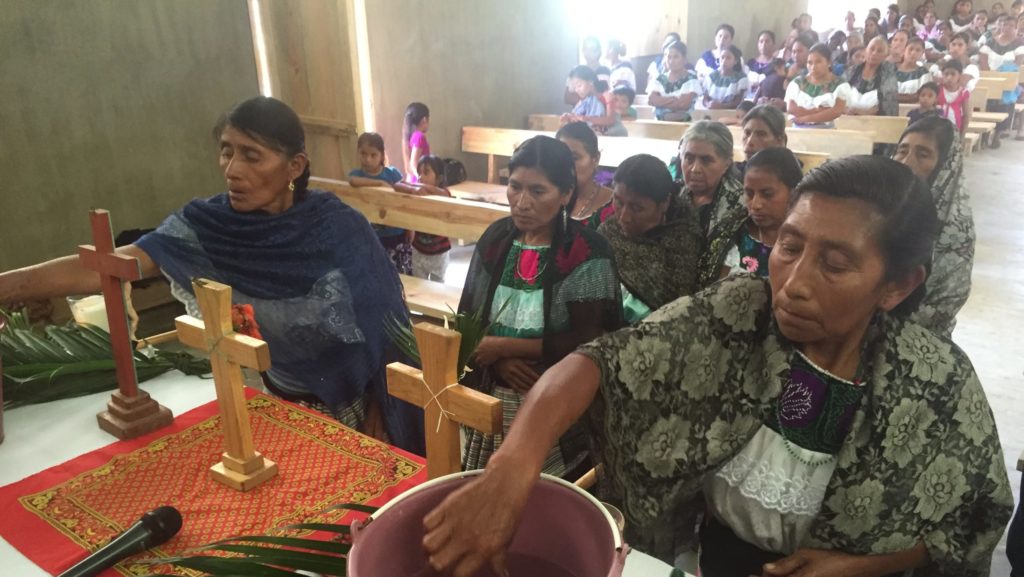A number of adaptations to the liturgy in Masses of Indigenous communities in the Mexican state of Chiapas were approved by the Vatican earlier this month.
Not only the celebrations can be conducted in their original languages, but also a few parts of the Mass were changed in order to respond to the cultural traditions of those groups.
Some of those modifications have been in place over more than five decades, being gradually incorporated by parishes and Catholic communities, according to the spirit of the Second Vatican Council. But the Diocese of San Cristobal de las Casas only began to work on an official systematization in 2007, Jesuit Father Felipe Ali Modad told Crux.
“Late Bishop Samuel Ruiz came back from the Second Vatican Council and promoted the work of inculturation of the liturgy. Translations of sacraments and prayers and the incorporation of new rites have been carried out since then,” said Modad, who coordinated the elaboration of the proposal sent to the Vatican.
When the diocese launched the process of studying such adaptations, priests and pastoral agents realized that most of them had common elements, despite being applied to different Indigenous groups and communities. Those were the aspects selected as general adaptations.
According to Bishop Rodrigo Aguilar, 75 percent of the people in the Diocese of San Cristobal de las Casas has Indigenous origin. There are five ethnicities in the region: Tzeltal, Tsotsil, Ch’ol, Tojolabal, and Zoque.
“Unfortunately, traditional cultural elements and language have been gradually losing strength among the youth. But the rites and habits connected to religion are preserved like a treasure,” Aguilar told Crux.
Modad explained that the geography of the region, mostly consisting of mountains, has somehow delayed the arrival of mass means of communication and of transportation that generally contribute to a fast cultural erosion of Indigenous traditions. Languages like Tzetal and Tsotsil are used in their daily lives by 2 million people in Chiapas, he said.
“Those languages were here for at least seven centuries before the Spanish invasion and continue to be the mother language of many people. It’s more natural for everybody to pray in their mother language,” Modad said.
He recalled the first proposition was sent to the Mexican Bishops’ Conference in 2007 and, after its approval, it was remitted to the Vatican. After several years of comings and goings, a new one was formulated in 2021. On Nov 8, the Dicastery for Divine Worship and the Discipline of the Sacraments gave its recognitio to the diocese.
One of the adaptations concerns burning incense in specific moments, like the beginning of the celebration, during the offerings and the consecration.
“In the Indigenous logic, first one must incense the place and the objects and then the veneration to God can occur,” Modad said.
According to Aguilar, that is a task mostly carried out by women. A ministry for incense burning was recognized by the Vatican.
Another adaptation is the introduction of the figure of the principal, a community or moral leader who guides a prayer after the greeting.
“He or she directs out loud the prayer in the name of the whole community. The members of the group usually follow it in a low voice, so we frequently hear a soft and beautiful murmuring,” Aguilar explained. Candles can be lit during that prayer. The ministry of the principal was also recognized.
The other adaptation involves moments of dance during Mass, which can happen after Communion, during the universal prayer or during the offerings.
“It’s a soft and slow – not a bustling – movement. It’s carried out in a contemplative and praying way. People thank God and ask for His help,” Aguilar said.
The music varies according to each community and group. Flutes and drums are traditionally used, but harps, guitars and violins are also common.
Aguilar emphasized that such modifications are totally consonant with the universal Church’s liturgy.
“The communion with the Catholic Church is not harmed. At the same time, those Indigenous groups’ particularities are also preserved. It’s a beautiful testimony of communion and synodality,” he said.
The changes have been approved for San Cristóbal de las Casas and neighboring Tuxla Gutiérrez, whose apostolic administrator is also Aguilar. Almost all Mexican bishops asked for the approval for the whole country’s Church, but the Vatican is still studying the applicability of those modifications in other dioceses.
The Bible has already been translated to Tsotsil and Tzetal and is currently being translated to other languages. The Missal will be edited in Tzetal in 2025.
According to Cardinal Felipe Arizmendi, Bishop emeritus of San Cristobal de las Casas and the major promoter of the adaptations, that work could be done only due to the presence of highly inculturated pastoral agents in the region.
“With them, we discovered ways to celebrate the liturgy with Indigenous Catholic rites. Those are not pagan rites. They are full of Catholic spirituality, in Chiapas’s cultural ways,” he told Crux.
Arizmendi said missionaries who “don’t open their hearts to those communities are seen as strangers by them,” so that is a work that requires full involvement.
“Rome is open to such adaptations, but they must be faithful to the Catholic creed and to the cultures at the same time,” he said.

